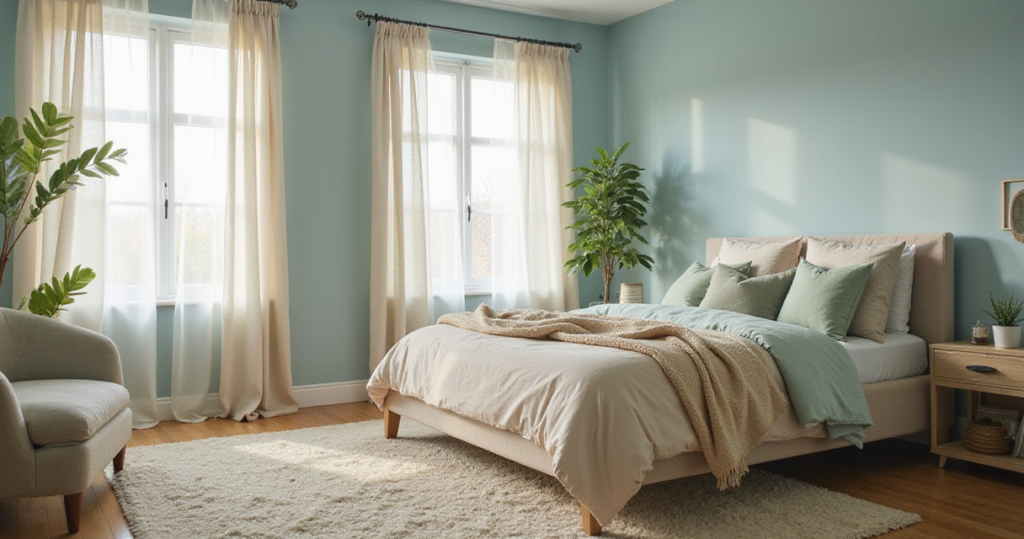Your bedroom should be the one place in the world where you can truly exhale. It’s more than a room; it’s a sanctuary. In my work, I find myself constantly mediating a conversation between two design philosophies: the soulful, organic principles of Vietnamese design and the clean, structural clarity of European modernism. One seeks harmony with nature and spirit, the other a rational elegance. And honestly, I don’t think you have to choose between them.
The most restorative spaces I’ve designed are born from this very dialogue. They are not about just following trends, but about understanding how the right materials, the flow of a room, and the quality of light can fundamentally change your sense of well-being. A bedroom isn’t a showroom. It’s the backdrop to your most private, quiet moments—the first light you see in the morning and the last space you inhabit at night. It deserves to be designed with intention.
So, let’s explore how you can craft a space that is both visually stunning and spiritually balanced. Think of this not as a rigid set of rules, but as a collection of ideas—a starting point for a conversation between your own history and your aspirations for a more serene life.
1. Find Your Palette in Nature, Not Just Paint Chips
The color of your walls is the first and last thing you see each day. Its effect is profound. While studies often point to cool tones like blues and greens for their calming physiological effects, the source of that color is what gives it soul. Don’t just pick a generic “sage green” from a swatch. Think about the muted, dusty green of eucalyptus leaves after a light rain, or the deep, almost-black green of lacquered panels I’ve seen in historic Vietnamese homes. These shades have a history and a depth that a flat color lacks.

I encourage clients to think in terms of a complete palette inspired by a specific landscape. Is it the cool, moody blues and charcoals of a North Sea coastline? Or the warm terracottas, creamy whites, and soft ochres of a sun-drenched Hanoi courtyard? Choosing 3-5 of these related tones creates an immersive, harmonious world. Use the dominant, atmospheric color for the walls, and layer the others through textiles and accents. You’ll feel the difference. It’s the difference between a room that is painted a color and a room that embodies a place.
With your colors chosen, the next step is to illuminate them. The right light can make a simple palette feel endlessly complex and alive.
2. Layer Your Lighting Like a Composer
A single, harsh overhead light is the enemy of serenity. It’s blunt and functional, casting unflattering shadows and creating a flat, uninviting atmosphere. To create a truly adaptable sanctuary, you must think of lighting in layers, like composing music. You need an orchestra—ambient, task, and accent lighting—working in harmony, all controlled by dimmers. This is non-negotiable.
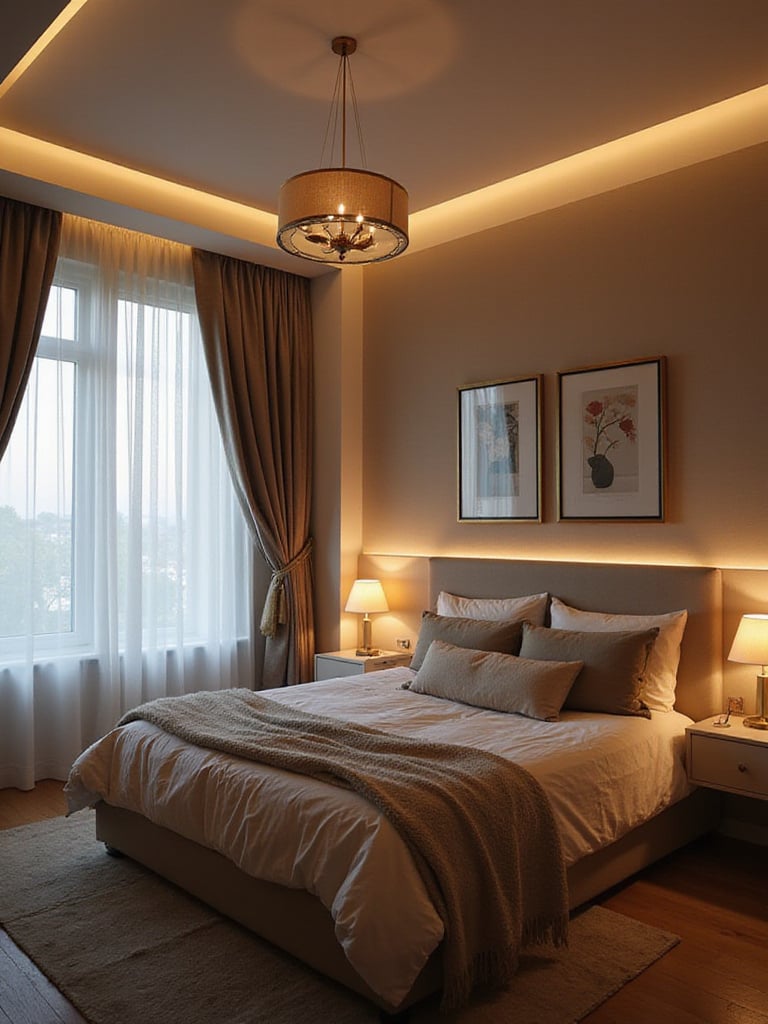
For a recent project in a Paris apartment, we floated a modernist chandelier for general, ambient light. But the magic was in the details: warm, low-wattage sconces flanking the bed for reading—perfect for one person to read while the other sleeps—and a hidden LED strip washing up the wall behind a Vietnamese silk screen, turning it from a simple art piece into a luminous feature. What really elevates a room is this ability to shift the mood with the flick of a switch, moving from bright and energizing in the morning to a soft, intimate glow at night.
Once the room is properly lit, you need to ensure the space itself flows. This is where furniture placement becomes a silent form of choreography.
3. Arrange Your Furniture to Guide, Not Obstruct
How you move through a space defines how you feel in it. In Eastern design, we talk about the flow of Qi, or life-force energy. You don’t need to be a feng shui master to understand its basic principle: a cluttered, awkward path creates a cluttered, awkward mind. Your bedroom’s layout should feel effortless and intuitive, creating clear, graceful pathways. I’ve found that simply rearranging furniture can make a room feel 20% larger.
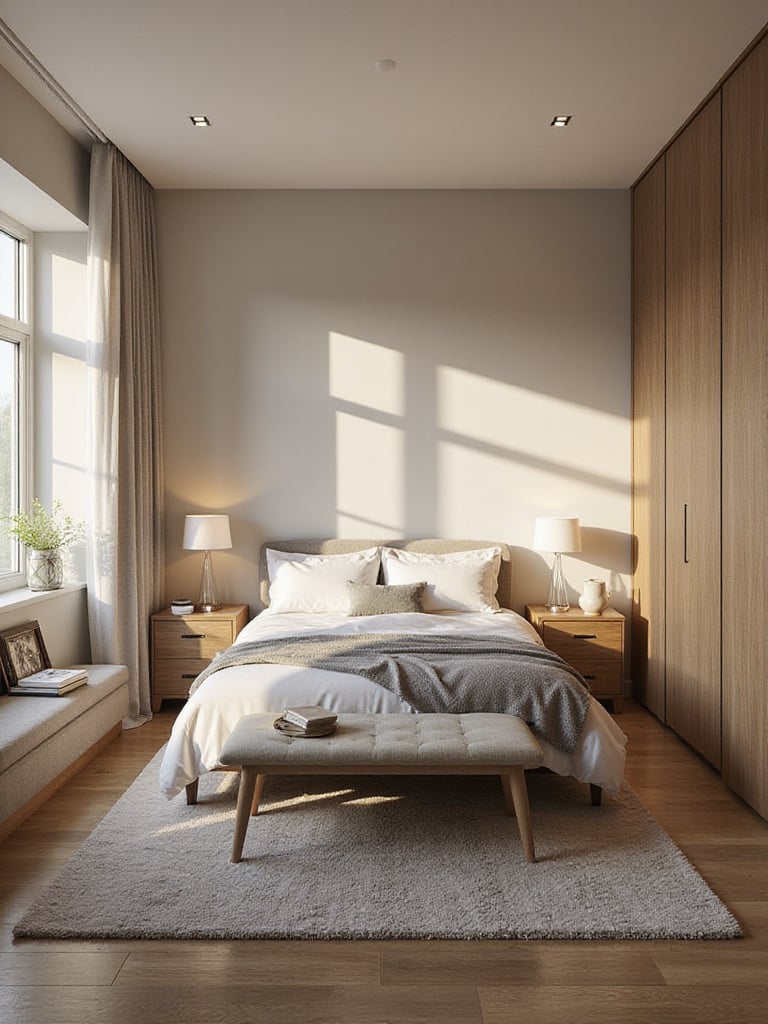
Start with the bed. It’s your anchor. Place it where it has a clear view of the door but isn’t directly in line with it. Then, ensure you have at least 24-30 inches of space on either side to move comfortably. Before you move anything heavy, try mapping it out with painter’s tape on the floor. See how it feels to walk from the door to the bed, to the closet, to the window. Does it feel natural? A well-designed room shouldn’t require you to zig-zag.
The bed is your anchor, and nothing establishes its importance more than what stands behind it.
4. Let a Statement Headboard Anchor the Room
The headboard is the throne of your sanctuary. It’s the single most powerful element for establishing the room’s character, drawing the eye and setting the entire design narrative. I love playing with the fusion of cultures here. Imagine a minimalist, low-profile bed—a nod to European modernism—set against a backdrop of intricately carved teak panels sourced from a Vietnamese artisan. The contrast is electric.

Your headboard choice is a dance between scale and material. In a room with high ceilings, a towering upholstered headboard in a rich velvet or linen can add a sense of European grandeur and luxury. In a smaller, more intimate space, I often prefer a headboard that extends the full width of the wall, perhaps in a warm, live-edge wood or even sleek, dark lacquer. It becomes less a piece of furniture and more a work of architectural art, grounding the entire room.
And what good is a beautiful headboard if what’s in front of it isn’t equally inviting?
5. Invest in Bedding That Breathes
Your bedding is the one element you are most intimate with. It touches your skin for hours every night. I’ll be blunt: high thread count is often a marketing gimmick. The real markers of quality are the fiber and the weave. Natural fibers like long-staple cotton, French or Belgian linen, and Tencel are superior because they breathe. They work with your body to regulate temperature, keeping you from feeling trapped and clammy like synthetics can.
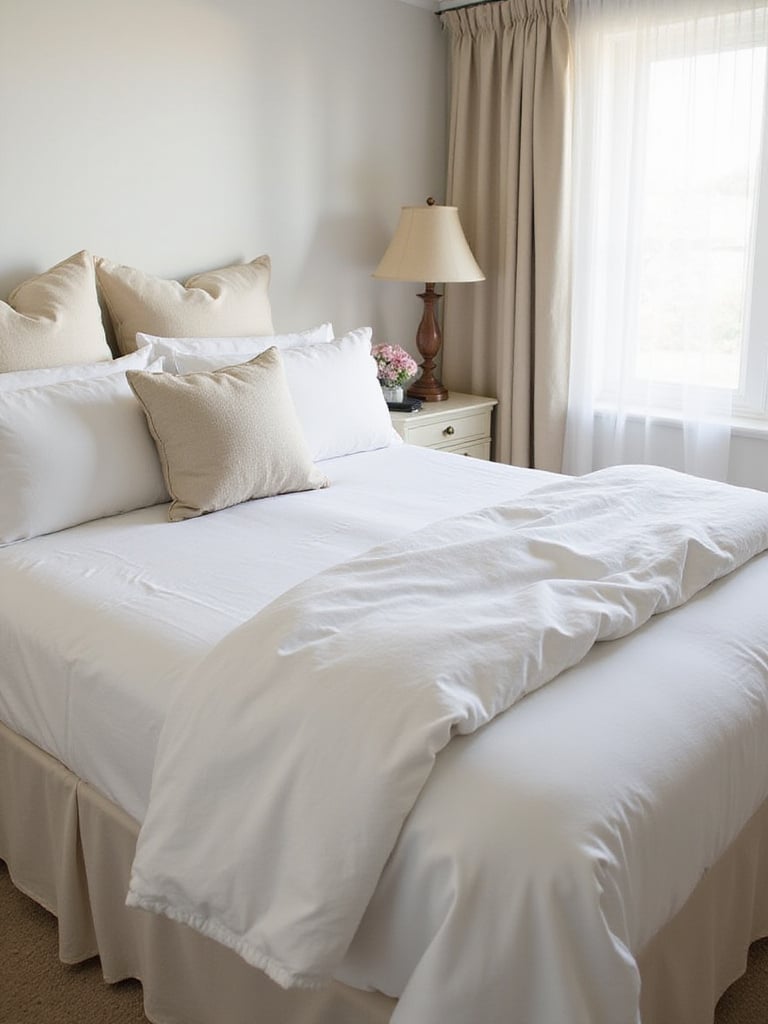
I am particularly fond of linen. Yes, it wrinkles—but that soft, rumpled texture is part of its charm. It has a casual elegance that feels both European farmhouse and tropical colonial. For those who prefer a crisper feel, a percale weave is clean and cool to the touch. For a silkier, more lustrous drape, sateen is your answer. Investing in one high-quality set from a maker like Parachute or Frette is a far better use of money than owning three mediocre ones. It’s a tangible, nightly return on investment.
But great design doesn’t stop at the sheets. It’s about creating a rich tactile world around you.
6. Weave in Lush Textiles Beyond the Bed
A room without layered textiles feels sterile and unwelcoming. It’s the textiles—the ones beyond your bedding—that truly soften a space and give it depth. Think of a heavy wool throw draped over a modernist Eames lounge chair, or sheer linen curtains that pool delicately on the floor, filtering the light into a soft haze. These layers are what turn a collection of furniture into a curated, comfortable whole.

The secret here is to play with texture while staying within your chosen color palette. I love combining contrasting materials: the smoothness of silk against the roughness of a hand-knotted wool rug, or a chunky knit blanket on top of a crisp cotton duvet. Each material catches light differently, creating a subtle visual richness. They also do incredible work absorbing sound, instantly making a room feel quieter and more cocoon-like.
And no textile does more to ground a space than the one under your feet.
7. Anchor the Room with the Right Rug
An area rug is the foundation of your bedroom’s design. It’s what pulls all the disparate pieces of furniture together into a single, cohesive composition. And there is nothing worse than a rug that is too small—it makes the furniture look like it’s floating in a sea of flooring. It’s one of the most common mistakes I see, and it instantly cheapens a room.
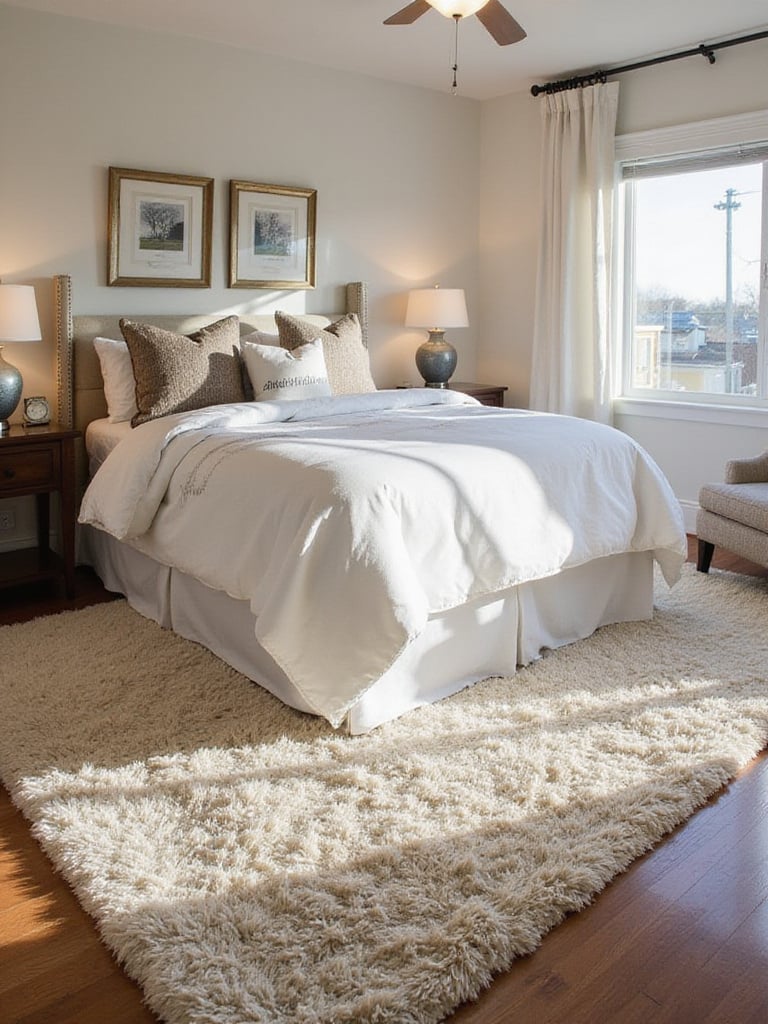
The rule of thumb is this: your rug should extend at least 18-24 inches beyond the sides of the bed. Ideally, your nightstands should also sit comfortably on the rug. This creates a defined, generous zone for your sleeping area, and provides a soft, warm landing for your feet every morning. A hand-knotted wool rug offers unparalleled durability and softness, while natural fibers like jute or sisal can bring a wonderfully organic, coastal feel that bridges Asian and European aesthetics.
With the foundational elements in place, it’s time to tell your story on the walls.
8. Curate a Wall That Tells Your Story
Your walls are not just structural. They are a canvas. What you choose to hang on them should be a reflection of your journey, not just a decorative afterthought. I always advise clients to move away from generic, mass-produced “art.” Instead, let’s create a gallery that feels uniquely yours. A mix of a contemporary print you bought on a trip to Berlin, a series of black-and-white family photos, and maybe a single, beautifully framed Vietnamese silk painting creates a narrative that is far more compelling.
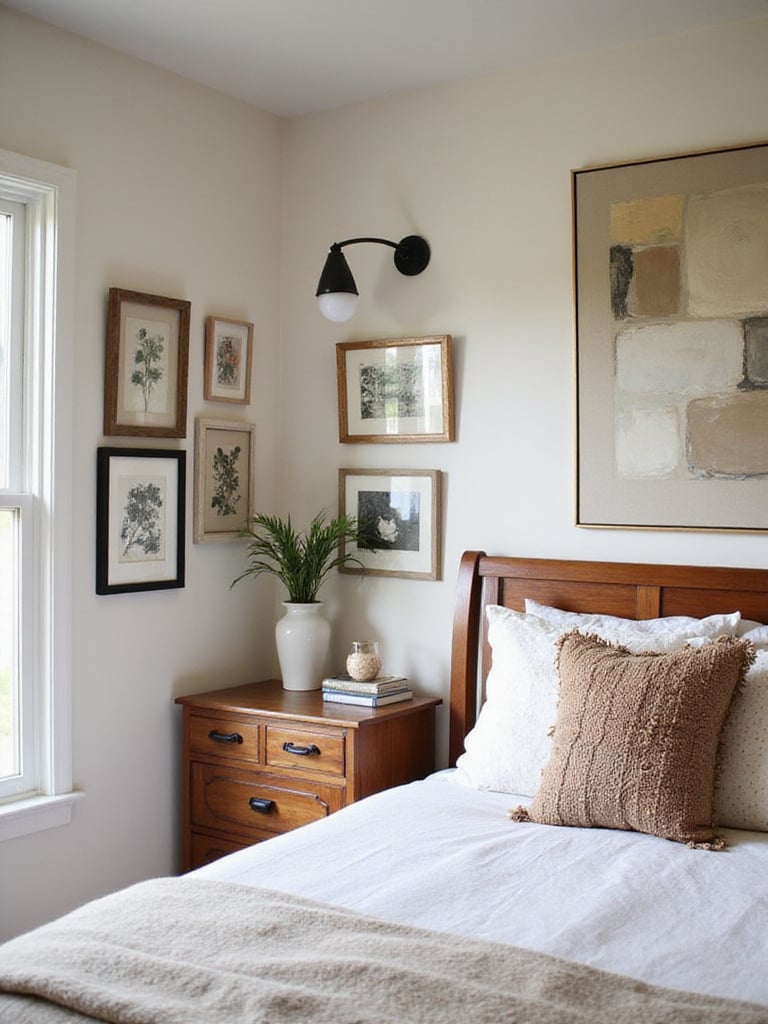
The key to a successful gallery wall is balance, not symmetry. Group pieces together, but vary the scale, orientation, and frame style. Create visual breathing room—what we call negative space—to let each piece have its moment. One of my favorite techniques is to find a common thread, perhaps a color that appears in each piece or a consistent theme, to tie a very eclectic collection together. This is where your personality truly comes to the forefront.
Now, let’s use another wall feature not just for decoration, but to fundamentally change the perception of the space.
9. Use Mirrors to Manipulate Light and Space
Mirrors are pure magic in the hands of a designer. They are the ultimate problem-solvers. In a small, light-starved bedroom, a well-placed mirror can be more effective than adding another window. It’s a classic trick, but one that’s often executed poorly. Don’t just hang a mirror anywhere; position it with purpose.
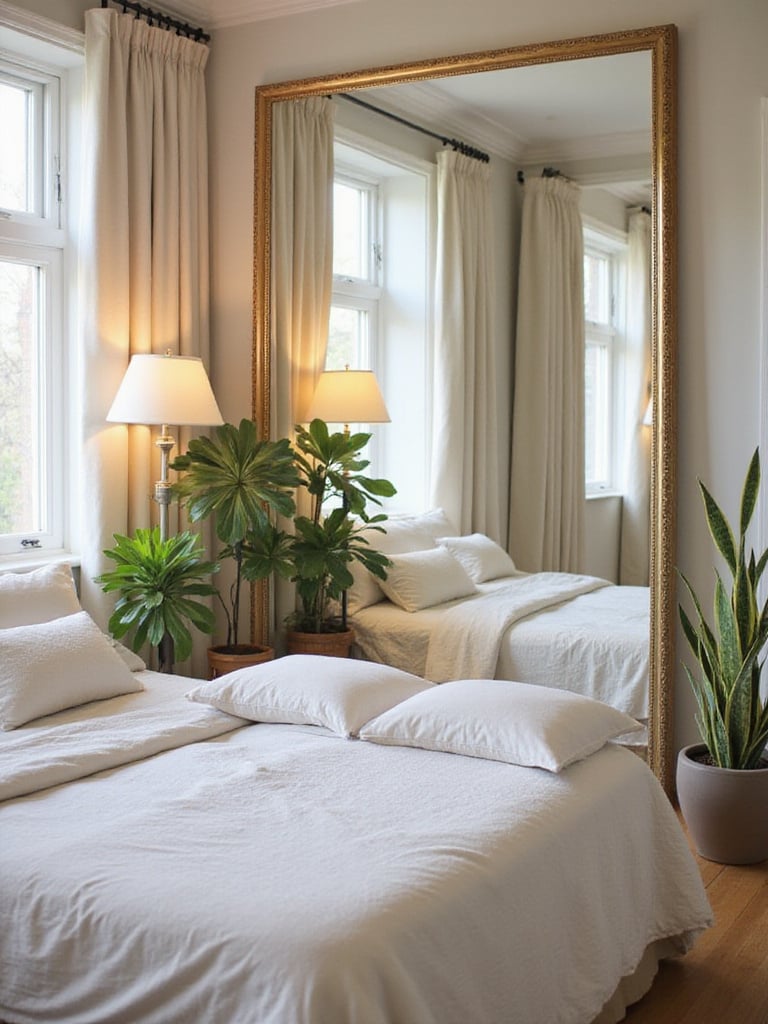
Place a large, floor-length mirror opposite a window. It will capture and bounce natural light all around the room, making the space feel instantly brighter and more expansive. Another powerful technique is to place a mirror behind a lamp on a dresser or console table; it doubles the light’s warm glow at night, adding incredible ambiance. Think of the mirror’s frame as another piece of art—a sleek, frameless design can lean modernist, while a burnished gold or carved wood frame can add a touch of old-world European or Asian charm.
From reflected light, we turn to living things that thrive in it.
10. Invite Life In with Greenery
A room without something living in it can feel static, almost sterile. Plants are the easiest way to breathe life, color, and vitality into your bedroom. They are a direct connection to the natural world, a concept central to Vietnamese design, and their presence has a demonstrably calming effect on our nervous system. Some plants, like the humble snake plant or a graceful peace lily, even work overtime, purifying the air while you sleep.
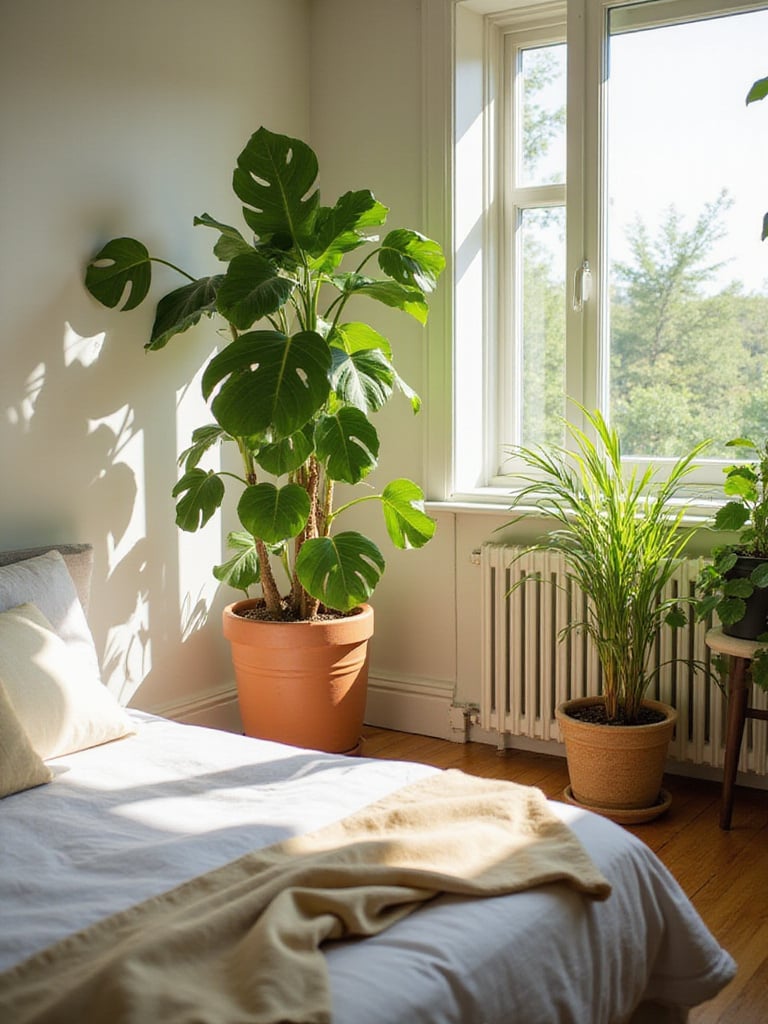
You don’t need a green thumb to make this work. Start with famously resilient plants like the ZZ plant or a pothos—they forgive a bit of neglect and tolerate lower light. Think about placement and scale. A large fiddle-leaf fig can serve as a stunning architectural element in an empty corner, while a small, delicate fern on your nightstand adds a touch of softness. Using beautiful, handcrafted ceramic planters elevates them from simple houseplants to living sculptures.
And just as plants help purify the air, smart storage helps purify the space of a more visible pollutant: clutter.
11. Banish Clutter with Integrated Storage
A serene bedroom and a cluttered bedroom cannot coexist. Clutter is visual noise, a constant, low-grade stressor that signals unfinished business. This is where the brilliant functionalism of modernism really shines. The goal isn’t just to hide your things, but to create elegant, integrated systems that make organization feel effortless. A well-designed space has a designated home for everything.
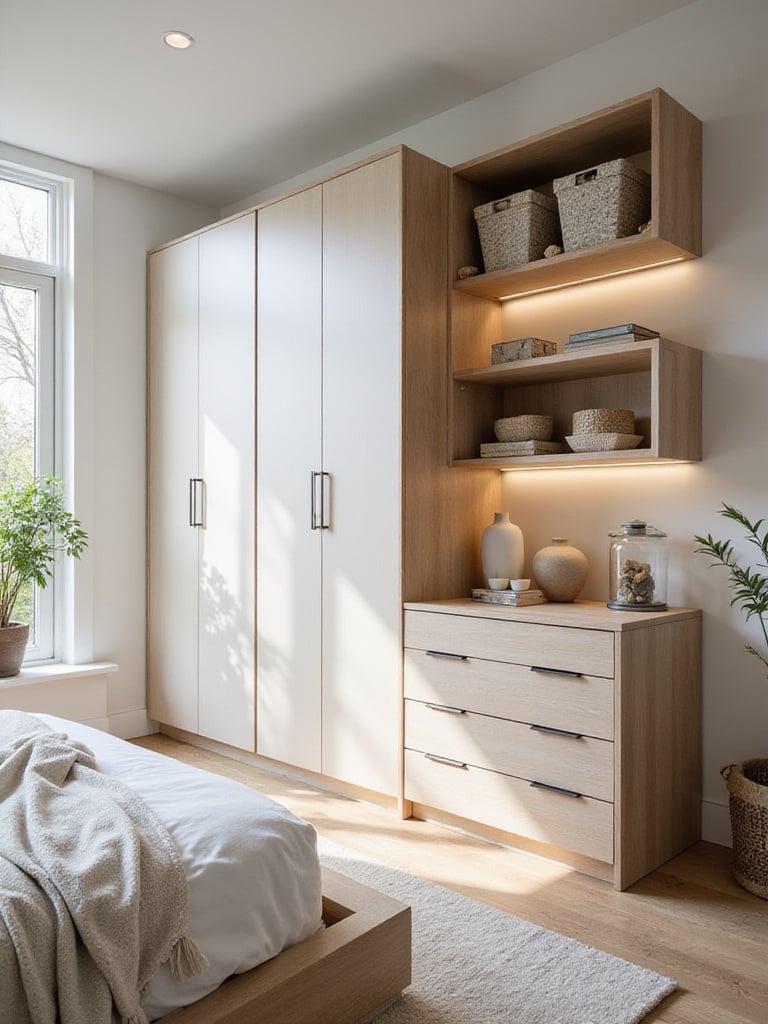
Under-bed storage with handsome wooden drawer fronts, a storage ottoman at the foot of the bed, or floor-to-ceiling built-in wardrobes that blend seamlessly with the wall—these are solutions that add function without sacrificing form. In one project for a family in a compact city apartment, we designed a custom platform bed with deep, integrated drawers. It completely eliminated the need for a bulky, separate dresser, liberating valuable floor space and creating a far more peaceful environment.
The path to serenity continues at the window, where light and privacy are negotiated.
12. Frame Your View with Intelligent Window Treatments
Your window treatments are doing more work than you think. They are modulating light, ensuring privacy, providing insulation, and making a significant stylistic statement. The key is flexibility. You want the ability to flood the room with morning light, but also achieve pitch-black darkness for deep, restorative sleep. This almost always means layering.

I am a firm believer in the two-layer system: a sheer or light-filtering blind for daytime privacy, paired with a heavy, opaque curtain for nighttime. Here’s a pro tip that instantly makes a room look more luxe: mount the curtain rod high and wide. Place it 6-12 inches above the window frame and extend it 10-14 inches on either side. This makes the window appear larger and grander, and when the curtains are open, they frame the view beautifully instead of bunching up and blocking precious light.
With the larger elements in place, we can now refine the space into dedicated areas.
13. Create Zones for Living, Not Just Sleeping
Even in a small bedroom, you can create the feeling of a larger suite by defining functional zones. Your room is not just for sleeping; it’s also where you might read, dress, or have a quiet moment with a cup of tea. Using furniture and decor to subtly delineate these spaces creates a more organized and versatile room.
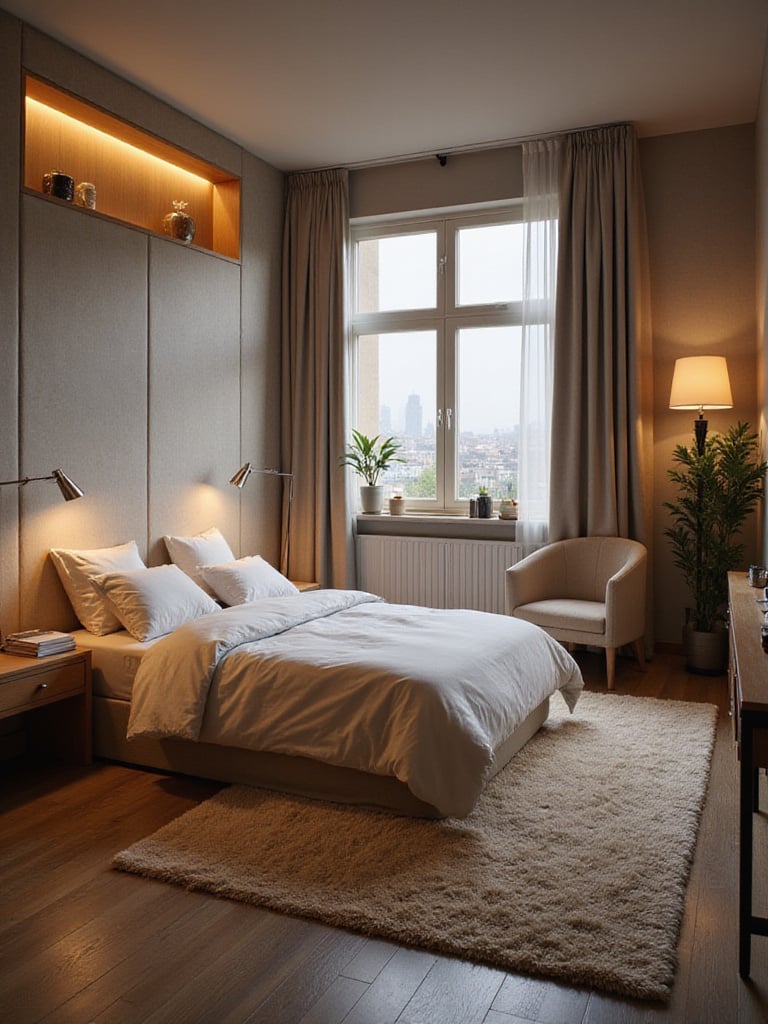
A comfortable armchair and a slender floor lamp instantly create an inviting reading nook. An elegant area rug can define the primary sleeping zone. A beautiful standing screen—perhaps a nod to traditional Asian interiors—can cleverly partition off a small dressing area from the rest of the room. This approach isn’t about building walls; it’s about using visual cues to signal a shift in function, making your bedroom work harder for you without feeling crowded.
As you define these zones, consider how to make them feel even more peaceful.
14. Insulate Your Sanctuary from Noise
Our sense of hearing is one of the most sensitive, especially when we’re trying to sleep. A quiet room is a restful room. While you can’t control the city noise outside, you can do a great deal to dampen it and absorb sound within the room itself. Soft surfaces are your best friend in this endeavor.

This is where all those lush textiles come into play again. The thick area rug, the upholstered headboard, the heavy curtains—they all act as sound absorbers, reducing echo and muffling outside disturbances. Even a large-scale textile art piece or a fabric wall hanging can make a significant difference. Placing your bed against an interior wall, rather than one shared with a neighbor or the street, is another simple but effective strategy.
And for the final sensory layer, we turn to the most transportive sense of all.
15. Evoke Calm with Scent
Scent is a powerful, direct line to memory and emotion. It’s often the most neglected element of interior design, but it has the power to instantly signal to your brain that it’s time to unwind. A signature scent for your bedroom can become a key part of your wind-down ritual, training your mind to associate it with rest.
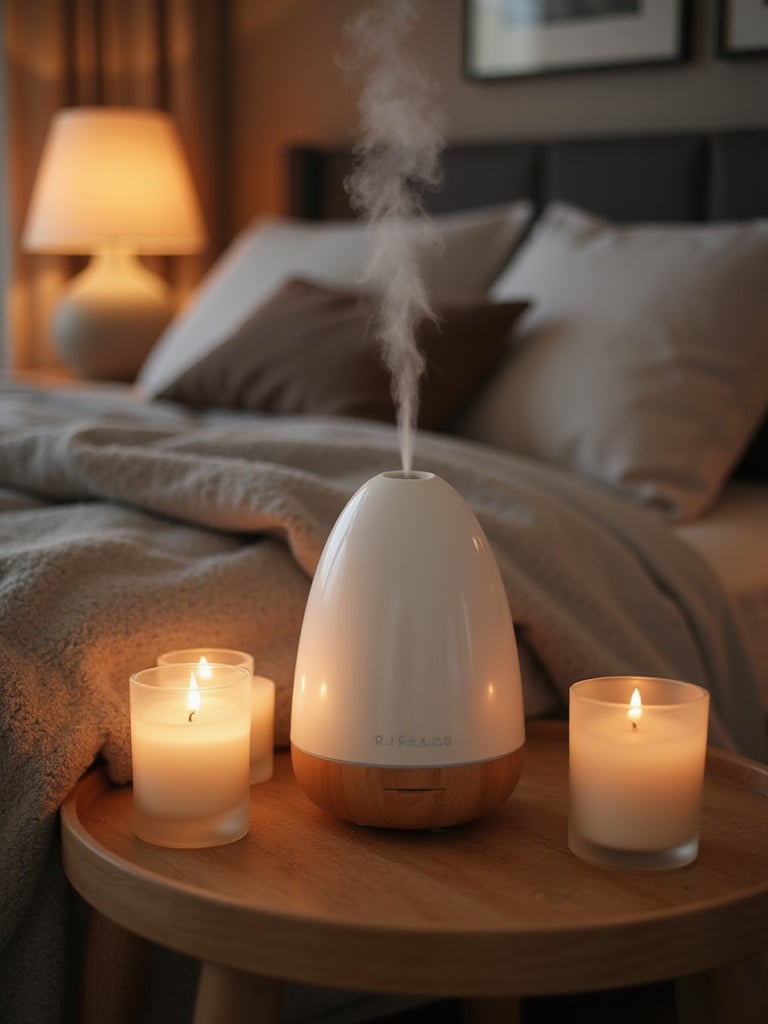
I tend to lean away from artificial air fresheners, which can be overwhelming. Instead, an essential oil diffuser offers a subtle, consistent, and customizable experience. Lavender, chamomile, and sandalwood are classic choices for relaxation. High-quality soy or beeswax candles can add a beautiful flickering ambiance, but please, use them safely. The goal is a gentle, background note—a hint of fragrance that creates a calming atmosphere, not a perfumed one.
Now that the room feels right, let’s make sure it feels like you.
16. Tell Your Story with Personal Objects
A room designed with impeccable taste can still feel cold and impersonal if it doesn’t contain pieces of your life. This is where you infuse your sanctuary with soul. Your most cherished objects—a collection of pottery from your travels, a framed letter from a grandparent, a sculpture you made in college—are what transform a house into a home.
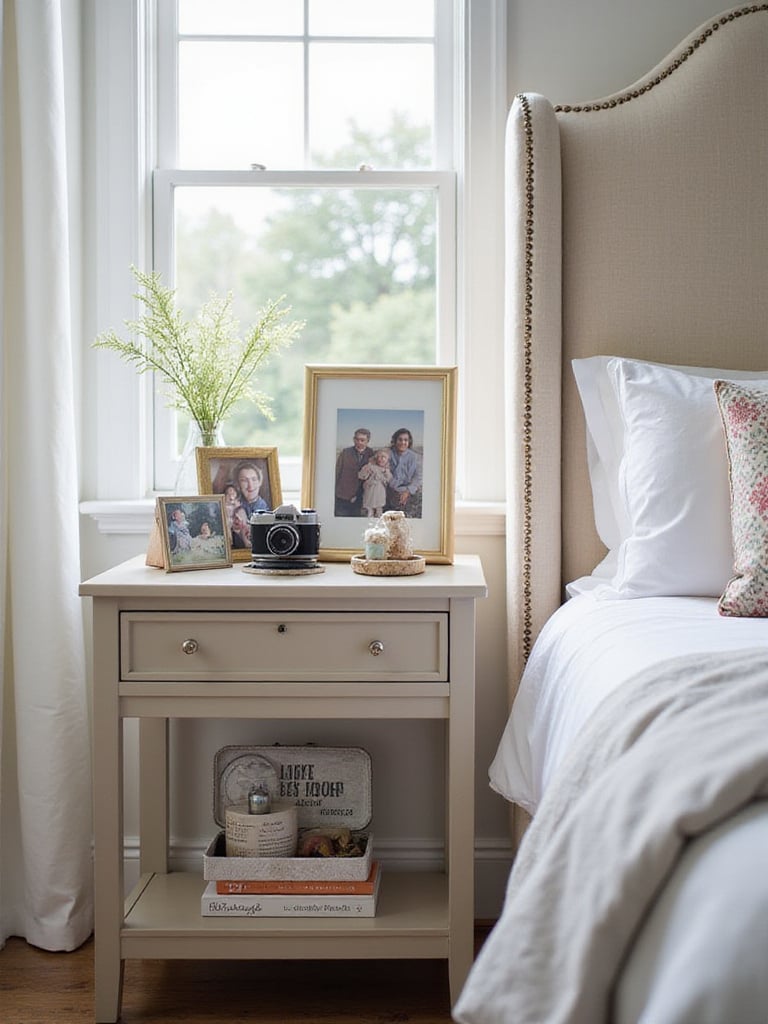
The art is in the curation. Instead of scattering items around, create intentional vignettes. Group objects on your dresser or bookshelf in odd numbers (threes or fives are always pleasing to the eye), varying their height and texture. A stack of art books, a small plant, and a treasured photograph can tell a story. This isn’t about creating clutter; it’s about elevating your personal history to the level of art.
As we bring in personal history, let’s also consider how modern tools can serve our daily rituals.
17. Embrace Tech That Serves, Not Distracts
Frankly, most “smart” technology just adds another layer of digital noise to our lives. But when applied thoughtfully, it can genuinely enhance the serenity of a bedroom. The key is to find technology that automates comfort and removes friction from your daily routines, rather than adding another screen to your life.

Imagine waking up not to a blaring alarm, but to lights that slowly brighten to mimic the sunrise, while your thermostat gently warms the room. Or setting an evening “wind-down” scene that dims the lights, lowers the blackout shades, and plays soft music with a single voice command. Smart home systems, when seamlessly integrated, should feel invisible. They should serve your well-being, not demand your attention.
Of course, creating a sanctuary doesn’t always require a high-tech or high-cost approach.
18. Master the High-Impact, Low-Budget Update
A dramatic transformation doesn’t have to come with a dramatic price tag. The secret to a successful budget refresh is to be strategic, focusing your resources on the changes that deliver the most visual and tactile impact. After years of sourcing, I’ve learned it’s always better to invest in one quality piece than several cheap ones.

Paint is, without question, the most cost-effective tool for a radical change. A new coat of paint in a carefully chosen color can completely redefine the room’s atmosphere. Beyond that, focus on textiles. A new duvet cover, a set of quality shams, and a rich throw blanket can make an old bed feel brand new. Swap out the generic hardware on your dresser for beautiful brass or ceramic knobs. Scour flea markets and online marketplaces for unique lighting or a vintage mirror. It’s these thoughtful, targeted updates that feel the most significant.
Finally, pulling all these ideas together requires a guiding vision.
19. Commit to a Cohesive Design Story
Whether you call it a theme or a concept, having a clear design direction is the thread that will tie all your choices together. It’s the compass that guides you, ensuring your bedroom doesn’t become a chaotic collection of disconnected ideas. Are you aiming for a serene, minimalist space inspired by Japanese and Scandinavian design (Japandi)? A rich, layered room that speaks to a bohemian, eclectic spirit? Or a clean, rational space rooted in European modernism?
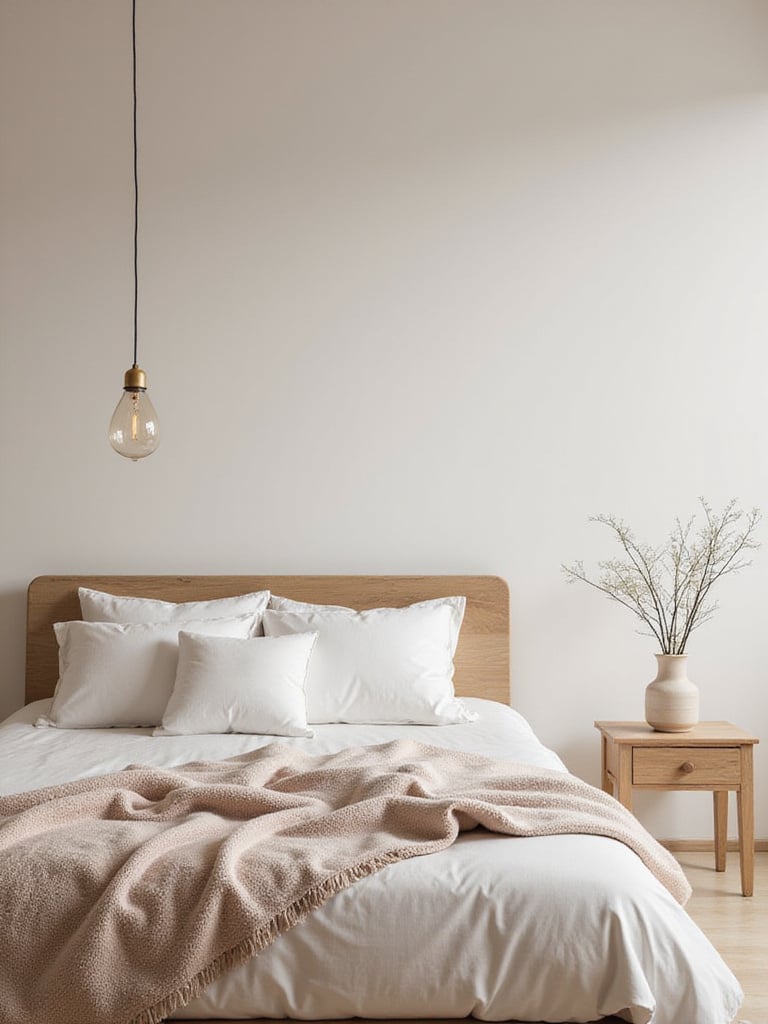
Take the time to gather images that resonate with you. Create a physical or digital mood board. You’ll start to see patterns emerge—a recurring color palette, a preference for certain materials, a particular furniture silhouette. This becomes your North Star. When you’re considering a new purchase, you can ask a simple question: does this support my design story? This simple test is the best way to ensure every piece in your room works together to create a harmonious, unified whole.
In Closing
Crafting your bedroom sanctuary is a deeply personal journey. It’s a dialogue between who you are and who you want to be when you are at your most quiet. These ideas are simply starting points, invitations to think more deeply about the space that holds you every night. The fusion of Asian and European design has taught me that the most beautiful interiors are those that balance clean, functional elegance with a rich sense of soul and story.
Don’t feel pressured to do everything at once. The most authentic spaces evolve over time, just as we do. Start with the idea that resonates most strongly with you—perhaps it’s finding that perfect, evocative color palette or finally investing in bedding that makes you feel incredible. Your bedroom is more than just a room. It is the beginning and end of your day. Investing in its serenity is an investment in your own. It’s a gift of peace you give yourself, every single day.
